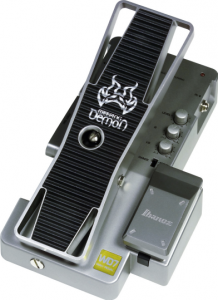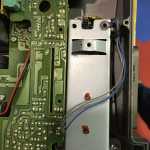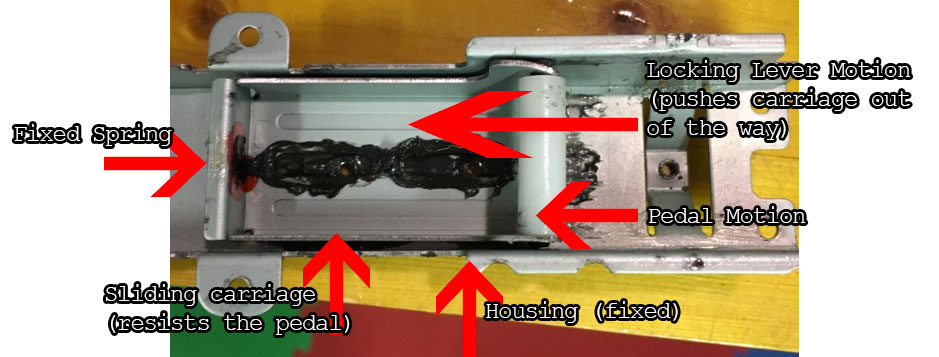By popular demand (OK, one person asked me about it recently), here’s an old post about my (then) recent repair of an Ibanez Weeping Demon Wah pedal (which conked out during an otherwise slammin‘ performance by Shades of Green). After our lead guitarist mentioned that it was the second of those he’d owned and the first one had broken the same way, it got me thinking that maybe it was a design weakness, so it may be a common problem. Before I start, let me apologize for not having photographed too much of this… I wasn’t planning to create a tutorial when I got started. Still, hopefully I can describe it well enough.

The Weeping Demon can function in two modes: Auto-Wah and some other mode, which I’ll call normal mode because I don’t know what they call it (amazingly, I could not find an instruction manual, nor photos of a disassembled Weeping Demon, nor really any help at all on the Internet.) In “Auto-Wah” mode, the pedal sits, heel down, until you step on it. As long as you’re working the pedal, you get the Wah effect, but if you take your foot off the pedal, it returns to the heel-down position, and the Wah effect turns off. In the other mode, the pedal is not spring-loaded, and the Wah effect is on all the time. You can switch between these two modes using a lever on the right side of the pedal.
The photo below shows the metal housing for a carriage that slides back and forth, providing spring-loaded resistance to the pedal. In the photo, the lever is seen on the right because this is seen from the bottom. Note the two red dots on the housing, they’re the screws that hold the carriage to the housing (you can see the screw heads in the next photo below).
What had happened, in this case, was that the pin that held the roller on the carriage came dislodged, and so stepping on the pedal would not force the carriage back, meaning that the pedal gets no resistance.
Disassembly was very straightforward. There are about eight or ten screws holding the bottom plate onto the pedal. As near as I can tell, these screws are all identical, so you don’t have to keep track of which goes where. Once the bottom plate was removed, I found a loose spring in the area of the battery box. At first I was sure that this spring had come loose from somewhere else, and was the reason why the pedal had lost its spring. It turns out that the loose spring is actually there to make the battery box button spring back. There’s a locator hole in the bottom plate that will indicate where to line it up when you go to reassemble the pedal.

I removed all of the screws from the circuit board and also those of the metal housing that covers the carriage (see photo above, it’s the only thing that looks like it.). You don’t need to remove the circuit board, but having the screws out allows you to move it just enough so that you can get the housing out. Once I did, I could see that the pin that held the carriage roller in place had come apart.

At first, I just pushed the roller back into place, and intended to just button things up and carry on. However, you can see that the tab on the carriage that the pin was still connected to had become bent, so the roller was pinched and wouldn’t rotate freely. So I took the carriage out of the housing and straightened the tab. (Sorry, I don’t have a photo of that).
I’m not entirely sure what caused this particular Weeping Demon to fail, but I suspect it may have had to do with aggressive use of the mode selection lever. The mode selection lever does two things: hold down the “Wah” switch, and hold the carriage back so that it doesn’t push against the pedal. I think that if the pedal isn’t in the “heel-down” position when you move the lever, it may stress the roller.

In the final analysis, it seems like the metal tabs that hold the pin (that holds the nylon roller) is the weak point in this design. The spring that resists the pedal action is fairly robust, as is the pedal itself. The lever that changes modes is pretty stout as well, and the nylon carriage and pin are strong enough. I think the tabs on the sides of the carriage are the weak point (although, to be fair something has to be the weak point, right?)
I suppose the best advice I could think to give to someone who wants to preserve their Weeping Demon would be to be reasonably gentle with it, particularly when shifting modes using the lever, because that action mechanically moves the carriage out of the way by pushing on the roller. Easing up on the tension of the return spring probably couldn’t hurt, either, since the pedal and the lever both push against it.
hey, first off just saying thanks; I used this tutorial awhile back and was able to fix my weeping demon, which is my favorite pedal.
I managed to break it again; looks like the spring itself is busted. Was wondering if you had any idea where to get a replacement for it? otherwise the pedal works great, and all my google searches are coming up empty. Hate to buy a new one just to replace a spring
thanks!
I got to fix the input the damn thing broke was thinking about using a stereo jack and solder to broken logic board?
This could work, as the jack is a pretty simple device. However, if it’s available to you, I’d suggest a mono jack, because your input is mono after all and you might just make your life simpler not having to deal with the additional contact.
Thank you so much for sharing this fix – (Ibanez weeping demon floppy pedal issue).
I had exactly the same problem & when I opened it all up it looked exactly the same as your images.
With a bit of dismantling, simple mechanics, pliers, screwdrivers, and a delicate hand + straightening the bent mechanism up (Inside) it now works as new !! (Watch out for that random spring in the battery compartment – simply place it back into position before re-fixing the base plate of the pedal – I suggest putting the fixing screws into that area first before the others on the base plate so that it holds in position as you work your way around.
Had a little struggle getting it all back together again, but I completely agree. The internal carriage mechanism is an obvious weak point in an otherwise “built like a tank” pedal.
Word to the wise as previously suggested – make sure the pedal is in the HEEL DOWN position before moving the AUTO SW & FOOT SW around. This is where I went wrong after a couple of beers. My bad !! Cheers. Tom.
Well, I took mine apart expecting to see this but it turns out my spring is broken – roller is just fine. It’s what you are labeling the fixed spring in your diagram.
Any input on dimensions? Mine is in 3 pieces, stretched in some and tightly coiled in others. I can see the diameter just fine, not sure on the length. Looks like it’s got an adjustment screw built into the housing so maybe it’s not so important to get the exact size…